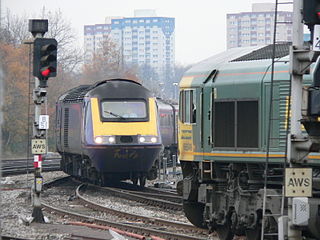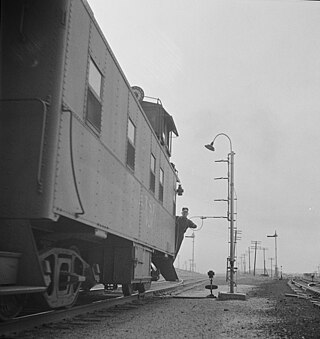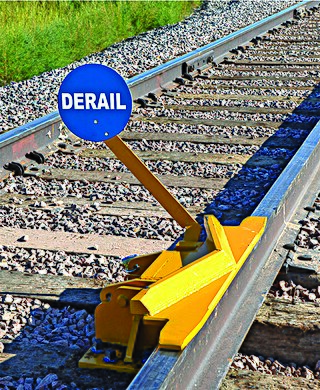
A level crossing is an intersection where a railway line crosses a road, path, or airport runway, at the same level, as opposed to the railway line crossing over or under using an overpass or tunnel. The term also applies when a light rail line with separate right-of-way or reserved track crosses a road in the same fashion. Other names include railway level crossing, railway crossing, grade crossing or railroad crossing, road through railroad, criss-cross, train crossing, and RXR (abbreviated).

A conductor or guard is a train crew member responsible for operational and safety duties that do not involve actual operation of the train/locomotive. The conductor title is most common in North American railway operations, but the role is common worldwide under various job titles. In Commonwealth English, a conductor is also known as guard or train manager.

A railway signal is a visual display device that conveys instructions or provides warning of instructions regarding the driver's authority to proceed. The driver interprets the signal's indication and acts accordingly. Typically, a signal might inform the driver of the speed at which the train may safely proceed or it may instruct the driver to stop.

Railway signalling (BE), or railroad signaling (AE), is a system used to control the movement of railway traffic. Trains move on fixed rails, making them uniquely susceptible to collision. This susceptibility is exacerbated by the enormous weight and inertia of a train, which makes it difficult to quickly stop when encountering an obstacle. In the UK, the Regulation of Railways Act 1889 introduced a series of requirements on matters such as the implementation of interlocked block signalling and other safety measures as a direct result of the Armagh rail disaster in that year.

Wigwag is a nickname for a type of railroad grade crossing signal once common in North America, referring to its pendulum-like motion that signaled a train's approach. The device is generally credited to Albert Hunt, a mechanical engineer at Southern California's Pacific Electric (PE) interurban streetcar railroad, who invented it in 1909 for safer railroad grade crossings. The term should not be confused with its usage in Britain, where "wigwag" generally refers to alternate flashing lights, such as those found at modern level crossings.

A train whistle or air whistle is an audible signaling device on a steam or gas locomotive, used to warn that the train is approaching, and to communicate with rail workers. Modern diesel and electric locomotives primarily use a powerful air horn instead of a whistle as an audible warning device. However, the word whistle continues to be used by railroaders in referring to such signaling practices as "whistling off".

On March 15, 1999, Amtrak's southbound City of New Orleans passenger train collided with a semi-trailer truck in the village of Bourbonnais, Illinois, United States. Most of the train derailed, killing eleven people. A National Transportation Safety Board (NTSB) investigation into the accident attributed the cause to the truck driver trying to beat the train across a grade crossing. The NTSB's recommendations from the accident included increased enforcement of grade crossing signals, the installation of train event recorders at all new or improved grade crossings, and procedures to provide emergency responders with accurate lists of all crew members and passengers aboard trains. The city of Bourbonnais erected a memorial near the site to commemorate those killed in the accident.

Train order operation is a system for safely moving trains using train orders, as opposed to fixed signals or cab signalling. In train order operation, a "train order" is an order issued by or through a proper railway official to govern the movement of trains".

The Abermule train collision was a head-on collision which occurred at Abermule, Montgomeryshire, Wales on Wednesday 26 January 1921, killing 17 people. The crash arose from misunderstandings between staff which effectively over-rode the safe operation of the Electric Train Tablet system protecting the single line. A train departed carrying the wrong tablet for the section it was entering and collided with a train coming the other way.

The 1995 Fox River Grove bus–train collision was a grade crossing collision that killed seven students riding aboard a school bus in Fox River Grove, Illinois, on the morning of October 25, 1995. The school bus, driven by a substitute driver, was stopped at a traffic light with the rearmost portion extending onto a portion of the railroad tracks when it was struck by a Metra Union Pacific Northwest Line train, train 624 en route to Chicago.

A brakeman is a rail transport worker whose original job was to assist the braking of a train by applying brakes on individual wagons. The advent of through brakes, brakes on every wagon which could be controlled by the driver, made this role redundant, although the name lives on, for example, in the United States where brakemen carry out a variety of functions both on the track and within trains.

A four-quadrant gate or full-barrier equipment is a type of boom barrier gate protecting a grade crossing. It has a gate mechanism on both sides of the tracks for both directions of automotive traffic. The exit gates blocking the road leading away from the tracks are equipped with a delay, and begin their descent to their horizontal position several seconds after the entrance gates do, so as to avoid trapping highway vehicles on the crossing. In the United Kingdom, the exit-side barriers do not lower until the entrance-side barriers have lowered.
Standards for North American railroad signaling in the United States are issued by the Association of American Railroads (AAR), which is a trade association of the railroads of Canada, the US, and Mexico. Their system is loosely based on practices developed in the United Kingdom during the early years of railway development. However, North American practice diverged from that of the United Kingdom due to different operating conditions and economic factors between the two regions. In Canada, the Canadian Rail Operating Rules (CROR) are approved by the Minister of Transport under the authority of the Railway Safety Act. Each railway company or transit authority in Canada issues its own CROR rulebook with special instructions peculiar to each individual property. Among the distinctions are:

A derail or derailer is a device used to prevent fouling of a rail track by unauthorized movements of trains or unattended rolling stock. The device works by derailing the equipment as it rolls over or through it.

Automatic block signaling (ABS), spelled automatic block signalling or called track circuit block (TCB) in the UK, is a railroad communications system that consists of a series of signals that divide a railway line into a series of sections, called blocks. The system controls the movement of trains between the blocks using automatic signals. ABS operation is designed to allow trains operating in the same direction to follow each other in a safe manner without risk of rear-end collision.

North American railroad signals generally fall into the category of multi-headed electrically lit units displaying speed-based or weak route signaling. Signals may be of the searchlight, color light, position light, or color position light types, each displaying a variety of aspects which inform the locomotive operator of track conditions so that they may keep their train under control and able to stop short of any obstruction or dangerous condition.

The application of railway signals on a rail layout is determined by various factors, principally the location of points of potential conflict, as well as the speed and frequency of trains and the movements they require to make.

Level crossing signals are the electronic warning devices for road vehicles at railroad level crossings.
Designs of level crossings, where railway lines cross roads or other paths, vary country-to-country.

The Baker Bridge train wreck occurred on November 26, 1905, in Lincoln, Massachusetts, when two passenger trains on the Fitchburg line of the Boston and Maine Railroad were involved in a rear-end collision. Seventeen people were killed in the wreck. Engineer Horace W. Lyons was charged with manslaughter; however, a grand jury chose not to indict him.



















